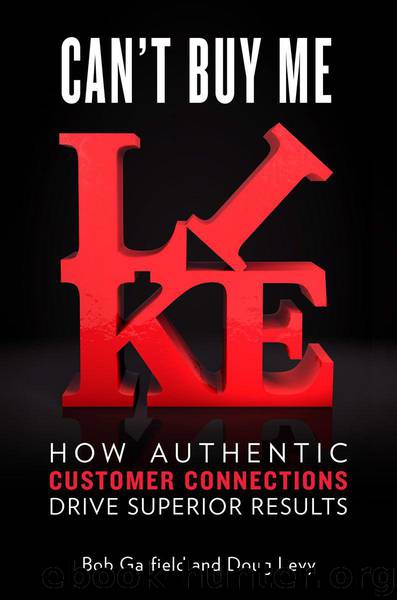Can't Buy Me Like: How Authentic Customer Connections Drive Superior Results by Bob Garfield & Doug Levy

Author:Bob Garfield & Doug Levy [Garfield, Bob]
Language: eng
Format: mobi, epub
Publisher: Penguin Group US
Published: 2013-03-06T14:00:00+00:00
At the Risk of Nitpicking
“There’s a very good parallel for this information,” Gosling says. “Primates will groom each other and they will groom each other much more than they strictly need to from a health perspective. Because what they’re doing when they’re grooming each other, picking the fleas or whatever from one another’s coat, they’re just doing it in a public way saying ‘we are connected and others can see that we are connected and that we are friends, right?’”
A common human manifestation of this, Gosling says, is when friends or acquaintances fuss extravagantly about one another’s appearance or recent purchase. “You know, when a group of people meet and they start cooing to each other. Like, ‘Oooh, I like your shoes!’ or ‘Oh, your hair’s so nice! Now you’ve cut your fringe!’ It’s ostensibly about the shoes, or the hair, or the football game last night. That’s what it seems to be like if you looked at the content. But really, that’s not what’s going on at all. It’s about the social act of maintaining and strengthening those social bonds.” A behavior for which the Like button is tailor-made.
“It’s not really about what people are saying. What it’s about is saying ‘Hey, I like you, you like me, we’re all friends. So should the time come, we can rely on each other.’ And I think really that clicking a Like in order to maintain social contact is very, very similar, it’s almost equivalent, to picking the fleas out of one another’s hair.”
Even when social bonds are weaker and the stakes are lower, he says, the Like affirmation is mutually reassuring. “It’s just a very casual, gentle way of saying, ‘Hey, I’m paying attention.’ I don’t have to do it regularly, but we are part of the same group and should we need each other. We’re all together.” You posted that HuffPo article about the dead guy in the foreclosed house? Here’s a Like for you, because, by golly, I care.
The anthro-socio-psycho-logy is compelling. If we can assume, however, that the human animal didn’t actually require any new channels for displaying its humanity to retain its humanity, then who really benefits from such channels existing? The answer, first and foremost, is Facebook. Before Like was introduced, Facebook’s recommendation function was a much more limited option to “Become a fan”—an action requiring more emotion and presumably more commitment than the transitory expression of approval of a single item of content. Like was meant to vastly increase the activity by lowering the threshold of admiration, and it worked.
Download
Can't Buy Me Like: How Authentic Customer Connections Drive Superior Results by Bob Garfield & Doug Levy.epub
This site does not store any files on its server. We only index and link to content provided by other sites. Please contact the content providers to delete copyright contents if any and email us, we'll remove relevant links or contents immediately.
Influence: The Psychology of Persuasion by Robert B. Cialdini(4714)
The Miracle Morning by Hal Elrod(4635)
The Hacking of the American Mind by Robert H. Lustig(4318)
Pre-Suasion: A Revolutionary Way to Influence and Persuade by Robert Cialdini(4142)
Unlabel: Selling You Without Selling Out by Marc Ecko(3587)
Ogilvy on Advertising by David Ogilvy(3503)
Hidden Persuasion: 33 psychological influence techniques in advertising by Marc Andrews & Matthijs van Leeuwen & Rick van Baaren(3472)
Purple Cow by Seth Godin(3137)
Who Can You Trust? by Rachel Botsman(3085)
Kick Ass in College: Highest Rated "How to Study in College" Book | 77 Ninja Study Skills Tips and Career Strategies | Motivational for College Students: A Guerrilla Guide to College Success by Fox Gunnar(3070)
The Marketing Plan Handbook: Develop Big-Picture Marketing Plans for Pennies on the Dollar by Robert W. Bly(2975)
This Is Marketing by Seth Godin(2969)
I Live in the Future & Here's How It Works by Nick Bilton(2933)
The Power of Broke by Daymond John(2893)
Building a StoryBrand by Donald Miller(2838)
The Tipping Point by Malcolm Gladwell(2819)
The 46 Rules of Genius: An Innovator's Guide to Creativity (Voices That Matter) by Marty Neumeier(2796)
Draw to Win: A Crash Course on How to Lead, Sell, and Innovate With Your Visual Mind by Dan Roam(2731)
Market Wizards by Jack D. Schwager(2643)
